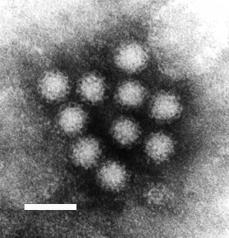Norovirus facts for kids
Quick facts for kids Norovirus |
|
|---|---|
| Synonyms | Winter vomiting bug, stomach bug |
 |
|
| Transmission electron micrograph of Norwalk virus. The white bar = 50 nm. | |
| Symptoms | Diarrhea, vomiting, stomach pain, headache |
| Complications | Dehydration |
| Usual onset | 12 to 48 hours after exposure |
| Duration | 1 to 3 days |
| Causes | Norovirus |
| Diagnostic method | Based on symptoms |
| Prevention | Hand washing, disinfection of contaminated surfaces |
| Treatment | Supportive care (drinking sufficient fluids or intravenous fluids) |
| Frequency | 685 million cases per year |
| Deaths | 200,000 per year |
Norovirus is a very common germ that causes a sickness called gastroenteritis. This sickness is often called the stomach flu or winter vomiting bug. It makes you feel sick to your stomach.
When you have norovirus, you might have diarrhea, throw up, or have a stomach pain. Sometimes, you might also get a fever or a headache. These symptoms usually start about 12 to 48 hours after you get the virus. Most people feel better in one to three days. It's rare to have serious problems, but some people can get dehydration. This means your body loses too much water. It's more common in young children, older people, or those who are already sick.
You can catch norovirus easily. It often spreads when tiny bits of poop from an infected person get into food or water. It can also spread from person to person, or from touching surfaces that have the virus on them. Sometimes, it can even spread through tiny drops in the air if someone vomits. You are more likely to get it if food is not prepared cleanly. Sharing small spaces with others also increases your risk. Doctors usually know it's norovirus based on your symptoms. Special tests are not usually needed.
Washing your hands well is the best way to stop norovirus from spreading. You should also clean surfaces that might have the virus on them. There is no vaccine to prevent norovirus. There is also no special medicine to treat it. The main treatment is to drink plenty of fluids. This helps prevent dehydration. You can drink special Oral rehydration solutions or other drinks without caffeine or alcohol. Hand sanitizers that use alcohol don't usually work well against norovirus.
Norovirus causes about 685 million cases of sickness each year around the world. It leads to about 200,000 deaths annually. It is common in both rich and developing countries. Young children under five years old get it most often. In developing countries, it causes about 50,000 deaths in this age group. Norovirus infections happen more often in the winter. It often spreads quickly in places where many people live close together, like schools or cruise ships. In the United States, norovirus causes about half of all sicknesses from contaminated food. The virus is named after Norwalk, Ohio, a city in the U.S. An outbreak happened there in 1968.
What are the Symptoms of Norovirus?
Norovirus infection can make you feel sick to your stomach. You might feel nausea, throw up, or have watery diarrhea. Stomach pain is also common. Some people might lose their sense of taste. Symptoms usually appear 12 to 48 hours after you are exposed to the virus.
You might also feel tired, weak, or have muscle aches. Headaches and a slight fever can happen too. The sickness usually goes away on its own. Serious illness is rare. Even though having norovirus can be very unpleasant, it is usually not dangerous. Most people get completely better within two to three days.
How Did We Learn About Norovirus?
The norovirus was first found after an outbreak in November 1968. This happened among children at Bronson Elementary School in Norwalk, Ohio, in the United States. Scientists first called it the "Norwalk agent."
In 1972, scientists looked at old human poop samples using a special microscope. They found a virus and named it "Norwalk virus." Since then, many outbreaks with similar symptoms have been reported. Scientists later found that these viruses belong to a family called Caliciviridae. In 2002, the name "norovirus" was officially approved for this group of viruses.
Over time, the virus has had other names. These include "Norwalk-like virus" and "small, round-structured viruses." The illness itself has also been called "winter vomiting disease" or "winter vomiting bug."
See also
 In Spanish: Norovirus para niños
In Spanish: Norovirus para niños

